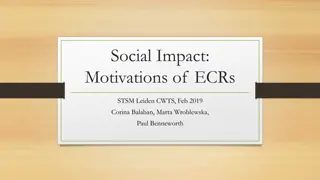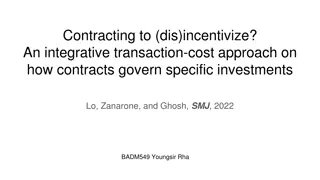Covering ECRs & Contractual Entitlements Overview
The content discusses Early Career Researchers (ECRs), contractual entitlements, appraisals, training and development opportunities, management roles and responsibilities, support services, flexible working options, and university benefits. It delves into the definition of ECRs, the Concordat principles, and review of recruitment and selection methods in Health Sciences for talent retention and research excellence.
Download Presentation

Please find below an Image/Link to download the presentation.
The content on the website is provided AS IS for your information and personal use only. It may not be sold, licensed, or shared on other websites without obtaining consent from the author.If you encounter any issues during the download, it is possible that the publisher has removed the file from their server.
You are allowed to download the files provided on this website for personal or commercial use, subject to the condition that they are used lawfully. All files are the property of their respective owners.
The content on the website is provided AS IS for your information and personal use only. It may not be sold, licensed, or shared on other websites without obtaining consent from the author.
E N D
Presentation Transcript
Adolescent Psychology PSYC 2307 Dr. Sara Villanueva
What Is Adolescence? The second decade of life (~10 to ~22) Used to be considered the teen years (13-19) but now Period of adolescence has lengthened why? Young people maturing earlier So many people delaying entering working world and marriage til their mid-20 s
Tough to Define Is a biologically mature 5thgrader an adolescent or a child? Is a 20-year old college student who still lives at home an adolescent or an adult? All depends on the boundaries one uses to define the period Makes more sense to think of adolescent development as a series of transitions from immaturity into maturity
Adolescence: A broad range Because this period spans over a decade, covering so much growth and change, Adolescence divided into 3 phases: Early adolescence: 10-13 Middle adolescence: 14-17 Late adolescence: 18-22 Correspond to anything?
Part I: The Fundamental Changes of Adolescence Chapter 1: Biological Transitions Chapter 2: Cognitive Transitions Chapter 3: Social Transitions
Chapter One: Biological Transitions
What is Puberty? From Latin word pubertas (adult) Period of lifespan in which an individual becomes capable of sexual reproduction Hormones regulated by the endocrine system lead to physical changes No new hormones are produced and no new bodily systems develop at puberty
The Endocrine System: HPG Feedback Loop HPG Axis: Hypothalamus Pituitary gland (master gland) Gonads (testes and ovaries) Gonads release sex hormones into bloodstream Androgens and estrogens
Somatic Development: Changes in Stature/Dimensions of the Body Adolescent growth spurt Simultaneous release of growth hormones, thyroid hormones, and androgens Peak Height Velocity Time that adolescent is growing most quickly Average female growth spurt is 2 years before the average male growth spurt
Somatic Development: Changes in Stature/Dimensions of the Body Skeletal changes Bones become harder, denser, more brittle Conclusion of puberty Closing of ends of long bones Growth in height is terminated Relative proportions of body fat/muscle change for boys and for girls Changes in the circulatory & respiratory systems
What Are The 3 Major Physical Changes of Puberty? Adolescent growth spurt Development of primary sex characteristics (gonads) Development of secondary sex characteristics (breasts, pubic hair)
How Do We Know? How do Scientists Investigate Pubertal Maturation?
Somatic Development: Sexual Maturation Development of secondary sex characteristics (Tanner Stages) Five Stages Changes include growth of pubic hair changes in appearance of sex organs breast development
Sexual Maturation: Boys Spermarche typically occurs 1 year after accelerated penis growth Boys capable of fathering a child before they look like adults; opposite true for girls 15
Sexual Maturation: Girls Sequence less regular than in boys Menarche typically occurs after other secondary sex characteristics; regular ovulation follows 2 years later Thus, girls appear physically mature before they are actually capable of reproduction 16
Variations in the Timing and Tempo of Puberty Onset can begin as early as 7 in girls and 9 in boys; as late as 13 in girls and 13 in boys Interval b/w first sign and complete physical maturation can be as short as 1.5 yrs or as long as 6 yrs
Ethnic Differences Within the U.S., there are Ethnic differences in timing and rate of pubertal maturation AA females mature significantly earlier than MA girls, who in turn, mature earlier than White girls Why the difference? Exposure to toxins in environment General SES Family dynamics
Puberty is Affected by Context Timing of physical changes in adolescence varies by Regions of the world Socioeconomic class Ethnic group Historical era Example: Menarche (first menstruation) U.S. average 12 to 13 years Lumi (New Guinea) average > 18 years
Individual Differences in Pubertal Maturation Pubertal maturation Interaction between genes and environment Differences in timing/rate among individuals in the same general environment result chiefly from genetic factors Two key environmental influences: nutrition and health Early pubertal maturation in girls is related to: Presence of a stepfather, experiencing childhood abuse, familial conflict, and growing up without a father
Individual Differences in Pubertal Maturation: What can effect the Timing of Pubertal Onset? EARLY LATE Higher affluence; economic advantages But what about Culture/Ethnicity? Poorer economic conditions History of protein and/or caloric deficiencies Better nourishment throughout prenatal, infant, & childhood yrs Chronic illness in childhood Better health conditions EXCESSIVE EXERCISE! Ballet dancers, Gymnasts Eating disorders Growing up in less cohesive families w/ more conflict Growing up in households w/ no natural father; instead having stepfather present (pheromones) Small amts of stress = speed up; great deals = slow down
Psychological/Social: The Impact of Specific Pubertal Events Most adolescents react positively to pubertal changes especially secondary sex characteristics Reactions to menarche are varied but less negative than in the past Less known about boys reactions to first ejaculations why?
Psychological/Social: Early or Late Maturation Perception of being an early or late maturer is more important in affecting one s feelings than the reality Early maturation does bring social advantages But early maturation is associated with More drug and alcohol use Precocious sexual activity Context is important to consider
What is an Eating Disorder? Eating disorders are serious but treatable illnesses with medical and psychiatric aspects Most commonly known are Anorexia and Bulimia Also includes Binge-Eating Disorder** Eating disorder not other wise specified is a classification of disorder that combines several diagnostic classifications but does not meet exact criteria for classic diagnosis Can become very serious, chronic, and even life threatening if not recognized and treated appropriately
The Scary Truth Eating disorders cause immeasurable suffering for victims and families Have reached epidemic levels in US- all segments of society 86% report onset of symptoms by the age 20 (peak age of onset 14-18) 77% report duration of illness from one to 15 years As many as 10% of patients with anorexia die Suicide contributes significantly to the death rate in eating disorders
The Role of Genetics We think genes load the gun by creating behavioral susceptibility such as perfectionism or the drive for thinness. Environment then pulls the trigger. Walter H. Kaye, M.D. 50 to 80% of cause is genetic AN and BN share common genes AN, BN run in families
Anorexia Nervosa Substantial self-induced weight loss or refusal to maintain weight at or above minimal normal weight for age and height (less than 85% of what is expected) Irrational (morbid) fear of fatness/gaining weight Intense drive for thinness Amenorrhea, i.e. absence of at least 3 consecutive menstrual cycles Two subtypes: (a)classic food restriction (ANR) and (b) binge- purge subtypes (ANBP)
Signs and Symptoms of AN Feeling cold compared to peers Hair loss/thinning scalp hair Development of lanugo hair (fair, downy hair on face and back) Decreased blood pressure/dizziness Decreased heart rate Dry skin, brittle nails Missing periods (females) Sad, depressed, moody, irritable Often display sensitive, perfectionistic, self-critical features Decreased levels of testosterone (males)
Bulimia Nervosa Recurrent episodes of binge eating characterized by the following: -Eating within discrete period of time an amount of food larger than most people would eat during the time and circumstances -A sense of lack of control over eating during the episode Recurrent compensatory behaviors (purging) to prevent weight gain: e.g..vomiting, laxative, diuretics, fasting, diet pills, excessive exercise. Self evaluation is defined by body shape and weight
Bulimia Nervosa Two sub-types: Purging type: individual regularly vomits or uses laxatives, diuretics, or enemas Nonpurging type: excessive exercise or fasting used in an attempt to compensate for binges
Signs and Symptoms of BN Preoccupation with food, weight and body Low energy/fatigue Stomach ulcers/bloating Dehydration/electrolyte disturbances Abrasions of knuckles Irregular heart beat, low blood pressure Constipation Irregular menstruation in women Depression, anxiety, guilt or shame, low self esteem Broken blood vessels in eyes http://anabootcamp.weebly.co m/commandments.html Sore, irritated throat
Binge Eating Disorder (BED) Recurrent and persistent episodes of binge eating Binge eating episodes are associated with three (or more) of the following: Eating much more rapidly than normal Eating until feeling uncomfortably full Eating large amounts of food when not feeling physically hungry Eating alone because of being embarrassed by how much one is eating Feeling disgusted with oneself, depressed, or very guilty after overeating Marked distress regarding binge eating Absence of regular compensatory behaviors (such as purging).
Things to think about Eating disorders are becoming more prevalent in the U.S., especially among young people Characterized by physically and/or psychologically harmful eating patterns 13.4% of girls and 7.1% of boys engaged in disordered eating patterns Factors associated w/ disordered eating: low self-esteem, depression, substance use, suicidal ideations The increasing emphasis on thinness (especially for women) is occurring as the population of the U.S. is becoming heavier 30-67% of normal-weight adolescent and college girls believe they are overweight 80% of ALL women are dissatisfied with their bodies
Important to know Differences b/w Anorexia & Bulimia People w/ Bulimia realize their eating patterns (binging/purging) are not normal frustrated and ashamed by that knowledge Bulimia much more prevalent than anorexia A person s weight has little to do with Bulimia whereas anorexic criteria is <15% normal body weight
Videos http://www.pbs.org/wgbh/nova/thin/program.html http://www.youtube.com/watch? v=Kh7M8yNKQ7M













![Importance of Rock v. MWB [2018] UKSC 24 as Explained by Lord Sumption](/thumb/193348/importance-of-rock-v-mwb-2018-uksc-24-as-explained-by-lord-sumption.jpg)









